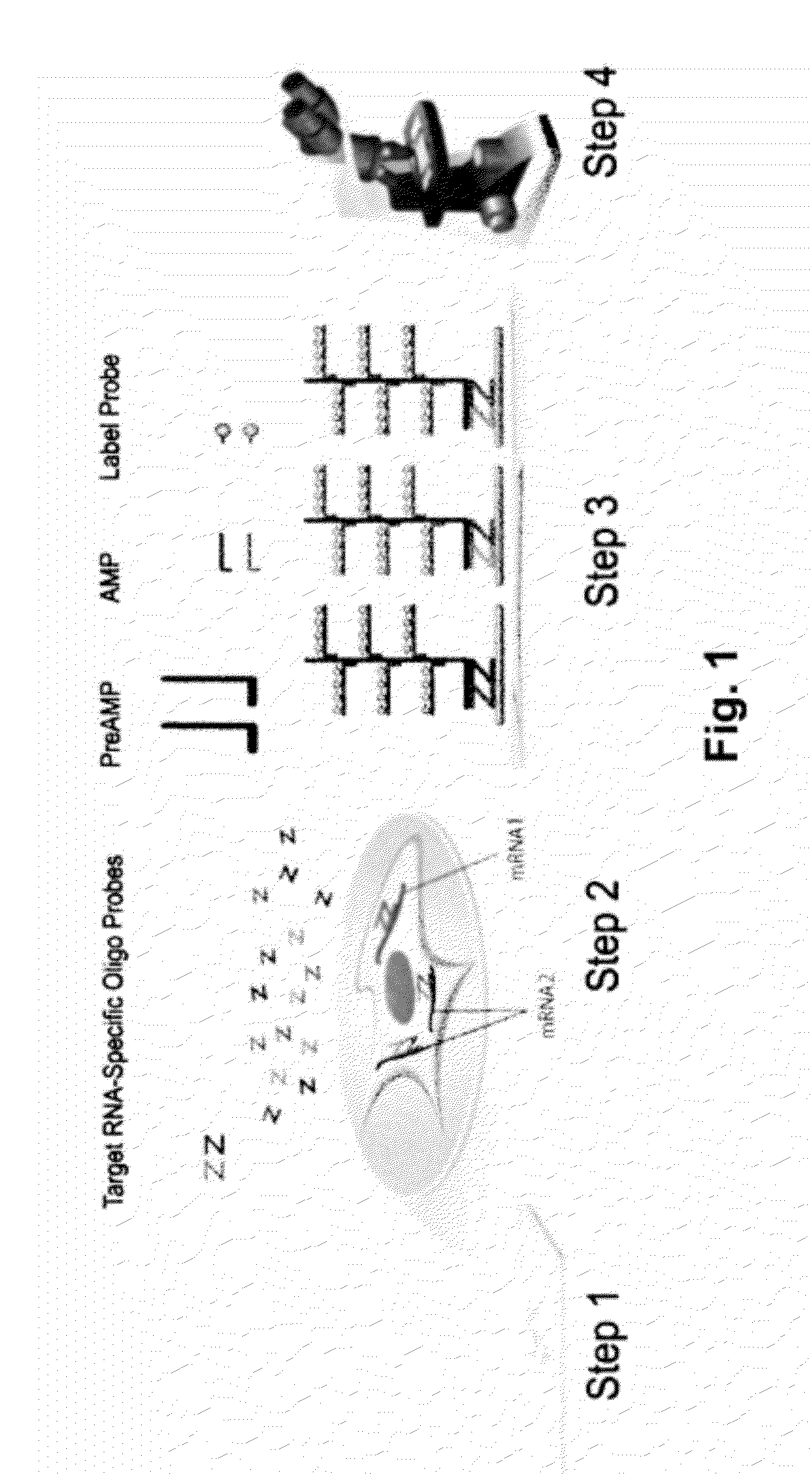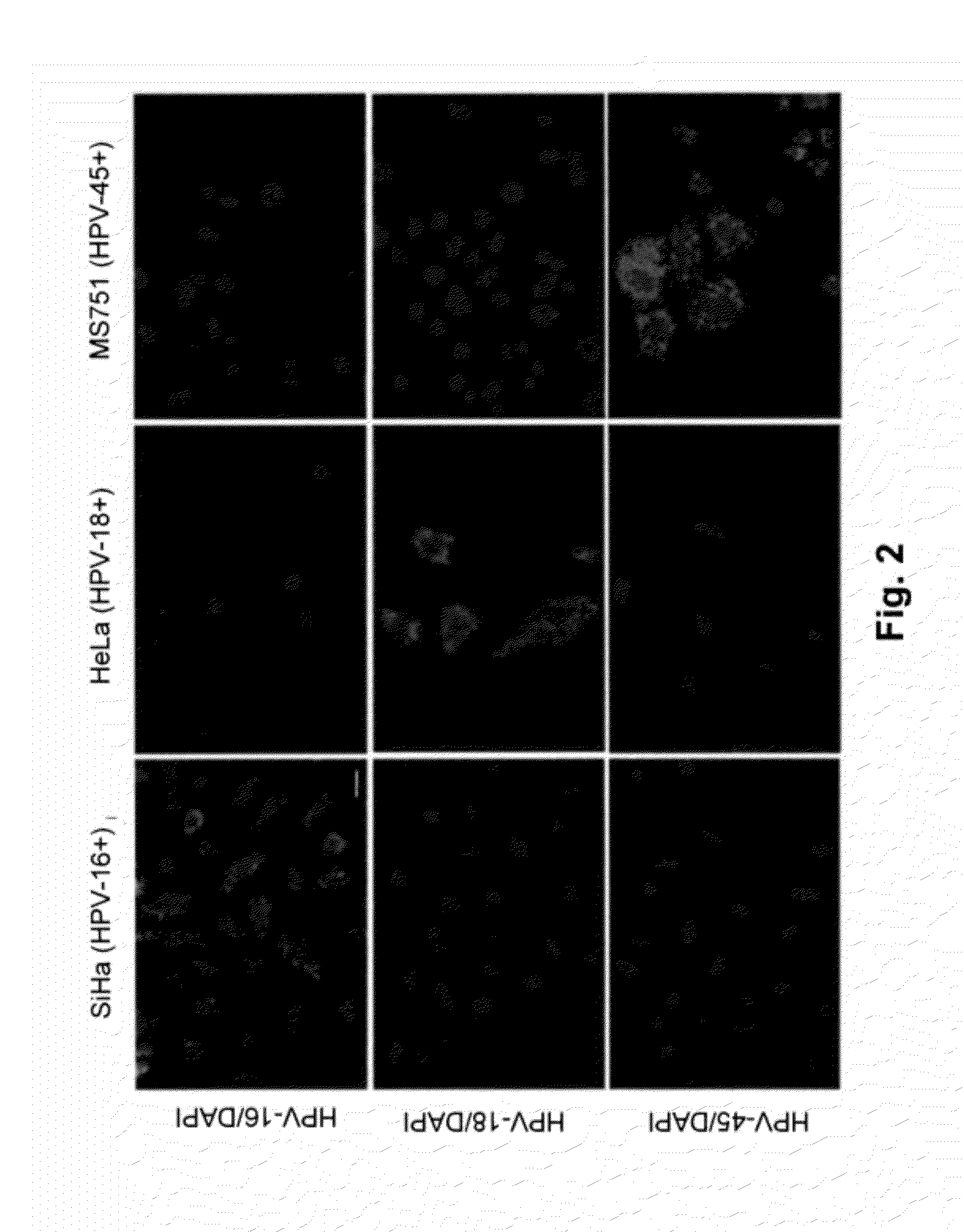Rnascope® HPV assay for determining HPV status in head and neck cancers and cervical lesions
a technology of hpv and assay, which is applied in the direction of biomass after treatment, biochemical apparatus and processes, specific use bioreactors/fermenters, etc., can solve the problems of cancer death for women, limitations of cervical cancer screening programs, and inability to biopsy
- Summary
- Abstract
- Description
- Claims
- Application Information
AI Technical Summary
Problems solved by technology
Method used
Image
Examples
example 1
Protocol for the RNAscope® HPV Assay
[0074]For each tumor sample, 5-micron tissue sections were cut and mounted on glass slides. The following steps were performed for each tumor sample:
[0075]1. Obtaining a sample from a subject. The sample can be a tissue sample obtained from a patient without preservation treatment or in a formalin fixed, paraffin embedded tissue section.
[0076]2. Optionally, if the sample is in a FFPE tissue section, the sample will be treated, first by heating the FFPE tissue section in a citrate buffer, and followed by digestion with a protease.
[0077]3. Performing an RNAscope® HPV assay on the sample, which includes the following tests:[0078]i) performing negative control using target probes against the bacterial gene dapB;[0079]ii) performing positive control using target probes against human gene UBC;[0080]iii) performing a test using HPV target probe sets containing either a pool of high-risk HPV subtypes or individual target probe set specific to one of these...
example 2
RNAscope® Detection of E6 / E7 mRNA of HPV Subtypes in Subtype-Specific Cell Lines
[0082]In order to demonstrate the feasibility of the RNAscope® HPV assay to detect and discriminate among different HPV subtypes, an experiment was conducted to detect HPV subtypes in cell lines which are known to contain only specific HPV subtypes. The protocol for the RNAscope® HPV assay described in Example 1 was used. The target probe sets are designed to be specific for E6 / E7 mRNA of HPV-16, HPV-18, and HPV-45, respectively. Hybridization of the probe sets to their target was detected using an alkaline phosphatase conjugated signal amplification system followed by development with Fast Red, which results in a red, fluorescent precipitate. As shown in FIG. 2, the HPV-16 target probe set produced a positive signal only in SiHa and CaSki cells, both of which harbor only the HPV-16 subtype. The HPV-18 target probe set produced a positive signal only in Hela cell lines which harbor only the HPV-18 subtyp...
example 3
RNAscope® Detection of HPV Subtypes in Head and Neck Cancer Tissue Samples
[0083]The following experiment was conducted to detect E6 / E7 mRNA of HPV high-risk subtypes in FFPE tissue samples obtained from HNC patients. In the experiment, the protocol for the RNAscope® HPV assay described in Example 1 was used. The two groups of target probe sets were created. In one group, the target probe sets contain only target probes that only bind to HPV-16. In the other group, the target probe sets contain target probes that bind to HPV-18, 31, 33, 35, 52, and 58 (called “HR-HPV probe set”). Multiple HNC patient samples who are diagnosed with cervical lesions were tested using the above groups of target probe sets. An exemplary result is shown in FIG. 3. The result shows detection of positive E6 / E7 mRNA of HPV high-risk subgroup in both patients. Both patients are known to have HPV-related HNC. Thus, the test proves that the RNAscope® HPV assay with the specifically designed HPV target probe set...
PUM
| Property | Measurement | Unit |
|---|---|---|
| reverse transcription real time PCR | aaaaa | aaaaa |
| epitluorescent microscope | aaaaa | aaaaa |
| prognosis power | aaaaa | aaaaa |
Abstract
Description
Claims
Application Information
 Login to View More
Login to View More - R&D
- Intellectual Property
- Life Sciences
- Materials
- Tech Scout
- Unparalleled Data Quality
- Higher Quality Content
- 60% Fewer Hallucinations
Browse by: Latest US Patents, China's latest patents, Technical Efficacy Thesaurus, Application Domain, Technology Topic, Popular Technical Reports.
© 2025 PatSnap. All rights reserved.Legal|Privacy policy|Modern Slavery Act Transparency Statement|Sitemap|About US| Contact US: help@patsnap.com



